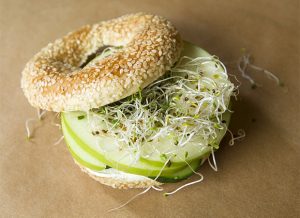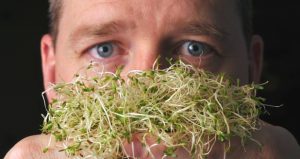The EKKA, Queensland’s agricultural showpiece, concluded last week in Brisbane, about the same time an uncomfortable memory was finally published in the peer-reviewed cyber-sphere.
 In Aug. 2013, 56 people became sick with E. coli O157 after contact with animals, or hanging out in the animal facility at the EKKA.
In Aug. 2013, 56 people became sick with E. coli O157 after contact with animals, or hanging out in the animal facility at the EKKA.
No child, or family, should have to go through grief and anguish because they took the kids to a petting zoo at the local fair.
Being repeatedly told they failed because they didn’t wash their hands is condescending. And ignores the science.
Handwashing is never enough.
At the time, a Biosecurity Australia dude said, “This highlights the importance of people practising sound hygiene measures following all contact with animals, their body fluids and excretions.”
How many want bureaucrats talking about body secretions?
As Anderson and Weese found in 2011 at a temporary petting zoo in Guelph (that’s in Canada) using video observation, 58 per cent of visitors performed some form of hand hygiene (either using water, soap and water, or hand sanitizer), and two interventions (improved signage while offering hand sanitizer, and verbal hand hygiene reminders by venue staff) were associated with increased hand hygiene compliance. U.K. health officials currently recommend handwashing stations with soap and water only (no wipes or sanitizers).
And while some studies suggest inadequate handwashing facilities may have contributed to enteric disease outbreaks or washing hands was protective against illness, others suggest relevant infectious agents may be aerosolized and inhaled.
In the fall of 2009, an E. coli O157:H7 outbreak at Godstone Petting Farm in the U.K resulted in 93 illnesses – primarily little kids.
The investigation into the Godstone outbreak identified evidence of environmental contamination outside the main barn, indicating acquisition of illness through both direct animal or fecal contact, and indirect environmental contact (e.g. contacting railings or soiled footwear).
Aerosolization of potential pathogens is also possible, as suggested in an E. coli O157:H7 outbreak at a county fair in Oregon, in which 60 people fell ill.
As part of the response to the Godstone outbreak, U.K. health types recommended handwashing stations with soap and water only (no wipes or sanitizers, because they don’t work that well under certain conditions).
Ihekweazu et al. subsequently concluded that in the Godstone outbreak, “handwashing conferred no demonstrable protective effect. …
“Moreover, from the findings of many previous published studies, it must be assumed that all petting or open farms are potentially high-risk environments for the acquisition of VTEC O157 infection (an STEC).”
This is what the Ekka folks had to say about the 2013 outbreak (which no one in Brisbane seems to know about).
 The 2013 Ekka agricultural show displayed >10,000 animals and included sections where direct contact between visitors and animals could occur. The animal boulevard included a large animal nursery where visitors could pat and feed farm animals, including goats, lambs, calves, piglets, chicks, ducklings, donkeys, and turkeys. A milking demonstration took place in an area adjacent to the animal nursery and visitors were invited to milk a cow. Unpasteurized milk was not served. Visitors could also view the birth of lambs that took place in an enclosed booth. The birthed lambs were available for supervised petting after >24 h after veterinary clearance. Other animals displayed in the animal boulevard and other pavilions were less accessible to the public for direct contact.
The 2013 Ekka agricultural show displayed >10,000 animals and included sections where direct contact between visitors and animals could occur. The animal boulevard included a large animal nursery where visitors could pat and feed farm animals, including goats, lambs, calves, piglets, chicks, ducklings, donkeys, and turkeys. A milking demonstration took place in an area adjacent to the animal nursery and visitors were invited to milk a cow. Unpasteurized milk was not served. Visitors could also view the birth of lambs that took place in an enclosed booth. The birthed lambs were available for supervised petting after >24 h after veterinary clearance. Other animals displayed in the animal boulevard and other pavilions were less accessible to the public for direct contact.
The number of visitors in the animal nursery was not restricted. Limited unsupervised handwashing facilities were available opposite the exit of the animal nursery. Hand sanitizers were available in other areas. Signs in animal contact areas encouraged visitors to wash their hands. Staff at the agricultural show regularly removed animal waste from animal contact areas.
Stool samples from 56 of 57 case-patients showed identical virulence gene profiles, consisting of stx1, stx2, eaeA, and ehxA . The virulence gene profile of the remaining probable primary case-patient was only stx2 and ehxA. Twenty bovine, 4 ovine, and 2 caprine fecal samples were tested from animals traced to other properties after the show had ended. Serotype O157:H- was confirmed from 51 of the human cases, and also from ovine, caprine, and bovine feces, and the animal bedding sample. All O157:H- isolated from animal and environmental sources displayed the same MLVA profiles (6_8_2_9_4_7_8_2_3_8 and 11–7-13–4-5–6-4–9) (Technical Appendix Table 2), stx1a and stx2c subtypes, and sequence type ST11, and 2/51 of human isolates differed by 1 allele in 1 of the MLVA profiles. Although E. coli O157 has frequently been reported to belong to sequence type 11 (13), the MLVA profiles were novel to the Queensland collection of previously typed STEC isolates (n = 112).
A table of petting zoo outbreaks is available at https://www.barfblog.com/wp-content/uploads/2017/08/Petting-Zoo-Outbreaks-Table-7-26-17.xlsx
Mild illness during outbreak of shiga toxin-producing Escherichia coli O157 infections associated with agricultural show, Australia
Emerging Infectious Diseases, vol. 23, no 10, October 2017, Bhakti R. Vasant, Russell J. Stafford, Amy V. Jennison, Sonya M. Bennett, Robert J. Bell, Christine J. Doyle, Jeannette R. Young, Susan A. Vlack, Paul Titmus, Debra El Saadi, Kari A.J. Jarvinen, Patricia Coward, Janine Barrett, Megan Staples, Rikki M.A. Graham, Helen V. Smith, and Stephen B. Lambert
https://wwwnc.cdc.gov/eid/article/23/10/16-1836_article
During a large outbreak of Shiga toxin−producing Escherichia coli illness associated with an agricultural show in Australia, we used whole-genome sequencing to detect an IS1203v insertion in the Shiga toxin 2c subunit A gene of Shiga toxin−producing E. coli. Our study showed that clinical illness was mild, and hemolytic uremic syndrome was not detected.
Erdozain G, Kukanich K, Chapman B, Powell D. 2012. Observation of public health risk behaviours, risk communication and hand hygiene at Kansas and Missouri petting zoos – 2010-2011. Zoonoses Public Health. 2012
Outbreaks of human illness have been linked to visiting settings with animal contact throughout developed countries. This paper details an observational study of hand hygiene tool availability and recommendations; frequency of risky behavior; and, handwashing attempts by visitors in Kansas (9) and Missouri (4), U.S., petting zoos. Handwashing signs and hand hygiene stations were available at the exit of animal-contact areas in 10/13 and 8/13 petting zoos respectively. Risky behaviors were observed being performed at all petting zoos by at least one visitor. Frequently observed behaviors were: children (10/13 petting zoos) and adults (9/13 petting zoos) touching hands to face within animal-contact areas; animals licking children’s and adults’ hands (7/13 and 4/13 petting zoos, respectively); and children and adults drinking within animal-contact areas (5/13 petting zoos each). Of 574 visitors observed for hand hygiene when exiting animal-contact areas, 37% (n=214) of individuals attempted some type of hand hygiene, with male adults, female adults, and children attempting at similar rates (32%, 40%, and 37% respectively). Visitors were 4.8x more likely to wash their hands when a staff member was present within or at the exit to the animal-contact area (136/231, 59%) than when no staff member was present (78/343, 23%; p<0.001, OR=4.863, 95% C.I.=3.380-6.998). Visitors at zoos with a fence as a partial barrier to human-animal contact were 2.3x more likely to wash their hands (188/460, 40.9%) than visitors allowed to enter the animals’ yard for contact (26/114, 22.8%; p<0.001, OR= 2.339, 95% CI= 1.454-3.763). Inconsistencies existed in tool availability, signage, and supervision of animal-contact. Risk communication was poor, with few petting zoos outlining risks associated with animal-contact, or providing recommendations for precautions to be taken to reduce these risks.














